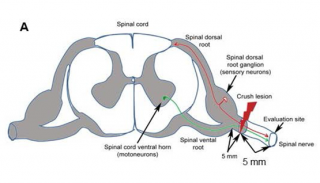
Schematic illustration of the surgical procedures. Crush lesion of sensory fibers (red) and motor fibers (green) in a cervical nerve between levels C6 and C7. The crush injury is performed 5 mm distal to the DRG. The regeneration of sensory and motor axons is evaluated at 5 mm from the lesion site (evaluation site).
Terpenoids, including squalene, are a group of compounds characterized by a wide diversity in chemistry, structure and function. Our aim is to use the extraordinary capacity of self-assembling of squalenic derivatives in aqueous medium as nanoparticles for the nanoformulation of macromolecules (siRNA) or small molecules (adenosine). We will assess their efficacies in the treatment of two disorders of the peripheral nervous system with unmet medical needs, the Charcot-Marie-Tooth disease type 1A (CMT-1A), a common hereditary demyelinating neuropathy, and the brachial plexus injury, a frequent trauma after traffic or sport accidents in adults or shoulder dystocia in newborns.
In the current project, we will introduce new therapeutic approaches, nanomedicines, by using squalenoyled molecules. Thus, we will produce siRNA in order to target the overexpression of PMP22, involved in the Charcot-Marie-Tooth disease type 1A (CMT-1A). Adenosine linked to squalene will be used to promote reconstruction of the brachial plexus after nerve root avulsion.
The research program will be performed by 4 NanoSaclay teams and will require:
- evaluating in vitro siRNA sequences,
- coupling the siRNA and adenosine to squalene,
- characterizing the structure of the resulting nanoassemblies,
- evaluating systemic toxicity, pharmacokinetics and nanoparticle cell internalization
- evaluating the pharmacological behavior of these nanomedicines in animal models.
This program will be performed in collaboration with two external partners specialized in neurological diseases: Charbel Massaad (UMR S_1124 Inserm and Paris Descartes University) and Michael Schumacher (U1195 Inserm and Paris-Sud University).
In a nutshell, this project investigating the use of siRNA PMP22-SQ and SQAd nanoparticles could, in case of success, open new therapeutic prospects for the treatment of CMT-1A disease and the reconstruction of the injured brachial plexus, both without current efficient treatments. This interdisciplinary project has concrete chances to reach industrial development and clinical applications.
Contact: , CNRS UMR 8203, Equipe: New anticancer therapies


